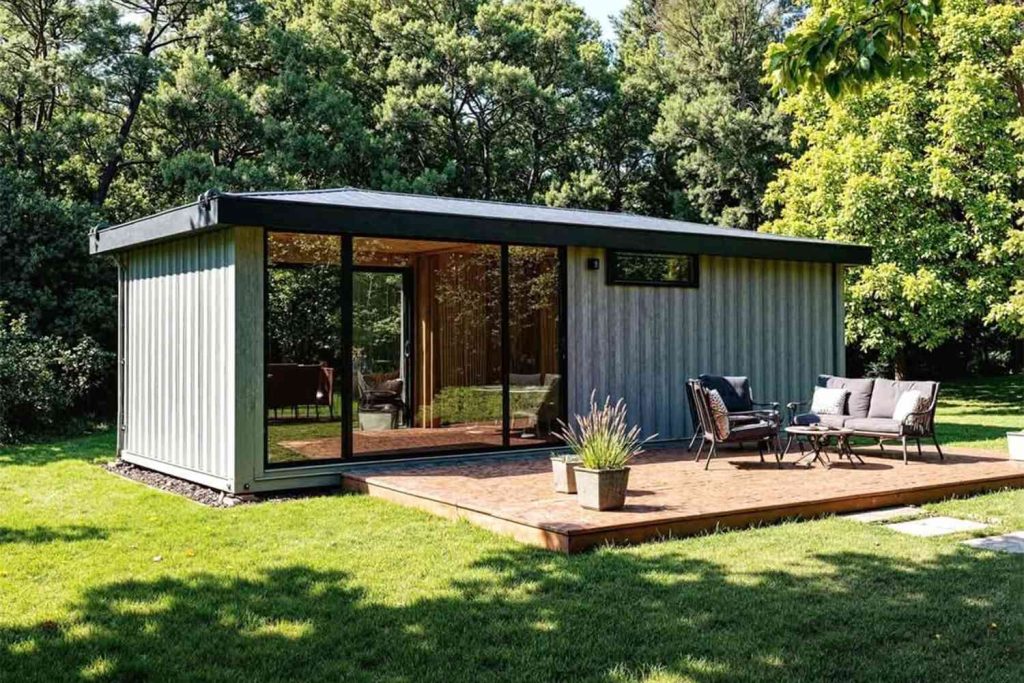Dreaming of Home Ownership? An Amazon Tiny House Could Be the Answer
For many, the dream of owning a home feels increasingly out of reach. Skyrocketing real estate prices, coupled with the burdens of traditional mortgages, leave many feeling trapped in a cycle of renting. But what if there was a more accessible path to homeownership? One that didn’t require emptying your life savings and signing on the dotted line for decades?
Enter the world of prefabricated tiny houses, and more specifically, the increasingly popular option of buying one through Amazon. This article delves into the feasibility and appeal of purchasing a tiny home through the online retail giant, focusing on a specific model and exploring the potential benefits and challenges of this unconventional approach to homeownership. We’ll also consider the broader implications of the tiny house movement and whether it represents a viable alternative to traditional housing, or simply a fleeting trend.
The Allure of Tiny Homes: More Than Just a Trend?
The tiny house movement has gained significant momentum in recent years, driven by a confluence of factors. For some, it’s a philosophical choice, a conscious rejection of consumerism and a desire for a simpler, more sustainable lifestyle. For others, it’s a pragmatic solution to the challenges of affordability, particularly in urban areas and regions with booming real estate markets.
Regardless of the motivation, the appeal of tiny homes is undeniable. They offer a chance to downsize, declutter, and minimize one’s environmental footprint. They can be incredibly versatile, serving as primary residences, vacation homes, guest houses, or even mobile living spaces. And, perhaps most importantly, they can be significantly more affordable than traditional homes.
Amazon: Your One-Stop Shop for Tiny Homes?
While Amazon might be best known for its vast selection of everyday goods, the online retailer has quietly become a player in the tiny house market. Their outdoor store features a variety of customizable tiny homes, offering a potentially convenient and affordable alternative to traditional home buying.
One particularly intriguing model, as highlighted by a recent article, is a luxury cabin-inspired design featuring two bedrooms, a full kitchen, and a bathroom, all for under $10,000. This price point alone is enough to turn heads, especially in areas where the average home price easily reaches six or seven figures. Let’s take a closer look at this “Off-Grid Tiny Home Kit” and explore what it has to offer.
Off-Grid Tiny Home Kit: A Detailed Look
What’s Included?
According to Lily Wang, a product manager for the manufacturing company ZHong Machinery, this model is a “hot selling” home, and for good reason. It arrives practically move-in ready, with pre-installed insulation, windows, doors, plumbing, and electrical outlets. The inclusion of a full bathroom with a toilet and full-sized shower, as well as a complete kitchen, makes it a truly functional living space.
One of the most appealing features is the abundance of natural light. Half of the front of the house is covered in floor-to-ceiling windows, creating a bright and airy interior, perfect for everything from morning yoga to simply enjoying the surrounding views.
Customization Options:
The manufacturer offers a degree of customization, allowing buyers to tailor the tiny house to their specific needs and preferences. At no extra cost, you can change the exterior color and the type of flooring. For an additional fee, you can even increase the size of the home up to 800 square feet and add up to three bedrooms, making it suitable for small families or those who need extra space for an office or guest room.
Sustainability Features:
For those concerned about their environmental impact, the option to include solar panels and a rainwater harvesting system is particularly appealing. These features can significantly reduce reliance on traditional utilities, lowering both your environmental footprint and your monthly bills. The rainwater harvesting system can collect water for drinking, washing dishes, and other household uses, further reducing your reliance on municipal water supplies.
Easy Assembly:
One of the biggest advantages of this tiny house is its easy-to-assemble design. The foldable walls simply need to be unfolded and installed into place, eliminating the time and effort required to build walls from scratch. This makes the construction process significantly faster and less daunting, even for those with limited building experience.
The Potential:
This tiny home could be used in a variety of ways:
- Rent-Free Living: For those willing to embrace a minimalist lifestyle, this could provide a genuine escape from the financial burden of rent.
- Weekend Cabin: A perfect escape for those seeking a connection with nature.
- Backyard Guest House: An ideal way to accommodate visiting friends and family, or even generate rental income.
The Fine Print: Considerations and Potential Challenges
While the prospect of owning a tiny home for under $10,000 is undoubtedly enticing, it’s crucial to approach this option with realistic expectations and a thorough understanding of the potential challenges.
- Land Acquisition: The cost of the tiny house itself is only one piece of the puzzle. You’ll also need to factor in the cost of land, which can vary dramatically depending on location. Researching zoning regulations and ensuring that tiny houses are permitted in your desired area is essential.
- Foundation and Utilities: Depending on your location and the intended use of the tiny house, you may need to invest in a foundation and connect to utilities such as water, electricity, and sewage. These costs can add significantly to the overall project budget.
- Building Codes and Permits: Local building codes and permit requirements can vary widely. It’s crucial to research these regulations and ensure that your tiny house meets all necessary requirements before beginning construction.
- Assembly and Construction: While the foldable design simplifies the assembly process, it’s important to consider whether you have the skills and resources to complete the project yourself. You may need to hire contractors for certain aspects of the construction, such as electrical or plumbing work.
- Quality and Durability: It’s essential to research the manufacturer and the materials used in the construction of the tiny house to ensure its quality and durability. Reading reviews and seeking expert advice can help you make an informed decision.
Beyond the Basics: Furnishing and Decorating Your Tiny Home
Once the tiny house is assembled, the fun begins: transforming it into a cozy and functional living space. Amazon offers a wide selection of home accessories, from comfortable bedding and bath mats to cookware and cleaning supplies. Choosing furniture and décor that is both stylish and space-saving is key to maximizing the functionality of a tiny home.
Is an Amazon Tiny House Right For You?
Purchasing a tiny house through Amazon is not a decision to be taken lightly. It requires careful planning, research, and a realistic assessment of your skills and resources. However, for those who are willing to embrace the challenges, it can offer a unique opportunity to achieve homeownership at a fraction of the cost of a traditional home.
Before you buy, consider the following:
- Budget: Calculate all potential costs, including land, utilities, permits, and construction.
- Location: Research zoning regulations and ensure that tiny houses are permitted in your desired area.
- Skills and Resources: Assess your ability to assemble the tiny house yourself or hire contractors.
- Lifestyle: Consider whether a tiny house lifestyle is a good fit for your needs and preferences.
Tiny Homes: A Sustainable Housing Solution?
The rise of the tiny house movement prompts an important question: could tiny homes play a more significant role in addressing the housing crisis and promoting sustainable living?
While tiny homes are not a panacea, they do offer several potential benefits:
- Increased Affordability: Tiny homes can make homeownership more accessible to a wider range of people.
- Reduced Environmental Impact: Tiny homes require less energy to heat and cool, and they generate less waste during construction.
- Increased Housing Density: Tiny houses can be placed on smaller lots, increasing housing density in urban areas.
However, to realize the full potential of tiny homes, it’s important to address some of the challenges they face:
- Zoning Regulations: Many zoning regulations restrict the construction of tiny homes.
- Financing: Obtaining financing for tiny homes can be difficult.
- Public Perception: Some people still view tiny homes as unconventional or undesirable.
Overcoming these challenges will require a collaborative effort between policymakers, builders, and advocates. By embracing innovative housing solutions like tiny homes, we can create more affordable, sustainable, and equitable communities.
Final Thoughts
The concept of buying a tiny home on Amazon might seem unconventional, but it reflects a growing desire for affordable and sustainable housing solutions. While it’s crucial to approach this option with careful planning and realistic expectations, the potential benefits are undeniable. For those willing to embrace a minimalist lifestyle and take on the challenges of construction and land acquisition, an Amazon tiny house could be a stepping stone towards homeownership and a more fulfilling way of life. Whether it’s a personal sanctuary, a weekend retreat, or a solution to housing affordability, the tiny house movement is undoubtedly sparking conversations about how we define “home” and how we can make it accessible to all.





